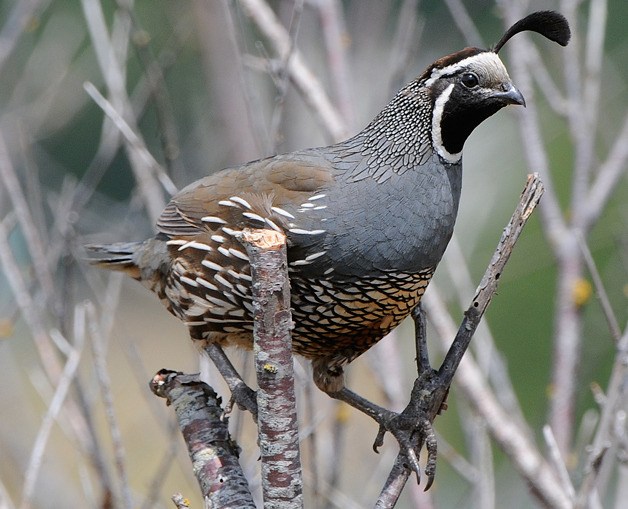Each morning I look out the window and search for “our” California quails. Usually, two pairs strut out from hiding in a native hedgerow and peck at the birdseed my husband and I scatter for them.
The males are elegantly and vibrantly plumed in black, grey and rufous; the females are more somber looking. But they both sport flamboyant, forward-facing topknots.
Most days one of the males hops up on a low decaying stump and sounds his syncopated, “Chi-CA-go, chi-CA-go.” Earlier this spring, that call alerted us to the return of this beloved species that has not been seen in our neighborhood for over eight years.
We have the ideal breeding habitat for this ground-nesting species, with a large half-acre patch of thick Nootka rose bushes. Prior to eight years ago, each spring we enjoyed seeing a covey of up to 20 quail.
Then one year they were gone. In early spring we might hear one lone male calling for a day or two, but soon that would stop and he would leave our neighborhood to call somewhere else.
There is no way to know why these birds left, but we’ve always suspected feral and outdoor cats played a significant role, by hunting the young and unwary adults.
We were so delighted when our quails returned.
Still, I worry that such a small covey of only four quail can sustain a population here. Certain bird species only survive in flocks. They benefit from having many pairs of eyes to watch for predators and locate food sources.
Perhaps you’ve read recently about the passenger pigeon, a species that went extinct about 100 years ago. Scientists are attempting to take DNA from museum specimens and find a way to create living birds. Their goal is to literally bring the species back to life.
They were once the most populous bird species in the country and needed big flocks to survive. Really huge flocks. Some estimate that three to five billion passenger pigeons lived in the United States when Europeans arrived.
John James Audubon described one flock as flying overhead in such thick numbers that they darkened the sky for hours on end. As the result of human desires to eat and eradicate them, the numbers decreased to non-sustainable-sized flocks. The population plummeted and the last one died in the Cincinnati Zoo in 1914.
Recently I chatted with a bird-loving friend who lives a couple of miles south of us in Clinton. This guy has trained chickadees to eat seeds from his outstretched hand and has been watching the birds in his garden for over 15 years. He bemoaned the recent decline of bird life.
He has noted fewer towhees, chickadees and nuthatches and mentioned that the white-crowned and song sparrows were mostly gone. When I asked what had changed, he replied that a new neighbor had moved in across the street with five outdoor cats.
Hearing this, I’m even more worried about our tiny flock of California quail. We all know that outdoor cats kill birds. Neither bells nor declawing nor being well fed will keep a tabby from chasing birds. Particularly during nesting season, April to August, it is important to keep all cats indoors.
I figure that if both our quail pair successfully raise six to eight young, we should be back to seeing our healthy quail covey in just a few years. Isn’t watching wild birds one of the sweetest benefits we have of living on Whidbey?
Frances Wood can be reached at wood@whidbey.com. Craig Johnson is at Craigjohnson@whidbey.com.


